Calder Trophy winner Aaron Ekblad showed rare excellence at age 19

Neither the oldest player nor the youngest player on the 2014–15 Panthers was on the team the previous season, when Florida finished with the second-worst record in the NHL. The oldest—until the arrival of Jaromir Jagr on Feb. 26—was 37-year-old defenseman Willie Mitchell, who signed with the team last August after having won the Stanley Cup with the Kings for the second time in three years.
The youngest, 19-year-old defenseman Aaron Ekblad, was the No. 1 pick in the 2014 NHL draft. He was just three years old when Mitchell entered the league in 1999.
Mitchell, the Panthers’ captain, was solid during the 2014–15 campaign, but it was Ekblad who helped vault Florida into the thick of the Eastern Conference playoff race. He set franchise rookie records for goals (12), assists (27) and points (39) last season. He quarterbacked the power play, and he averaged 21:48 of ice time, second only to defensive partner Brian Campbell (23:13).
While December was Ekblad’s best month statistically, he continued to shine as the season progressed. On Feb. 10, he showed his penchant for the 200-foot game when he collected a pass inside the blue line from Jonathan Huberdeau on a rush and smoked a shot past Ducks goaltender Ilya Bryzgalov’s blocker, helping the Panthers to a 6–2 rout of Anaheim. On Feb. 19 against the Canadiens, Ekblad played 31 shifts and registered a season-high 27:38 of ice time in a 3–2 shootout victory.
Did we mention he’s only 19?
“People don’t understand how hard [it] is,” Mitchell said in early February, a few days before Ekblad’s 19th birthday. “Eighteen to play in the NHL is one thing. To succeed at a high level is another. To be one of the best players on your team is another. And to do it at a position which is the hardest position to break into in the NHL, is special.”
Mitchell who with his wife, Megan, shared his home with the precocious blueliner, added, “We have a tough stretch to get into the playoffs. And we don’t even stand a chance if we don’t have him.”
Though the Panthers ultimately faded and finished seven points behind the Penguins for the Eastern Conference’s second wild-card berth, Ekblad is a big reason why Florida’s future looks brighter by the day.
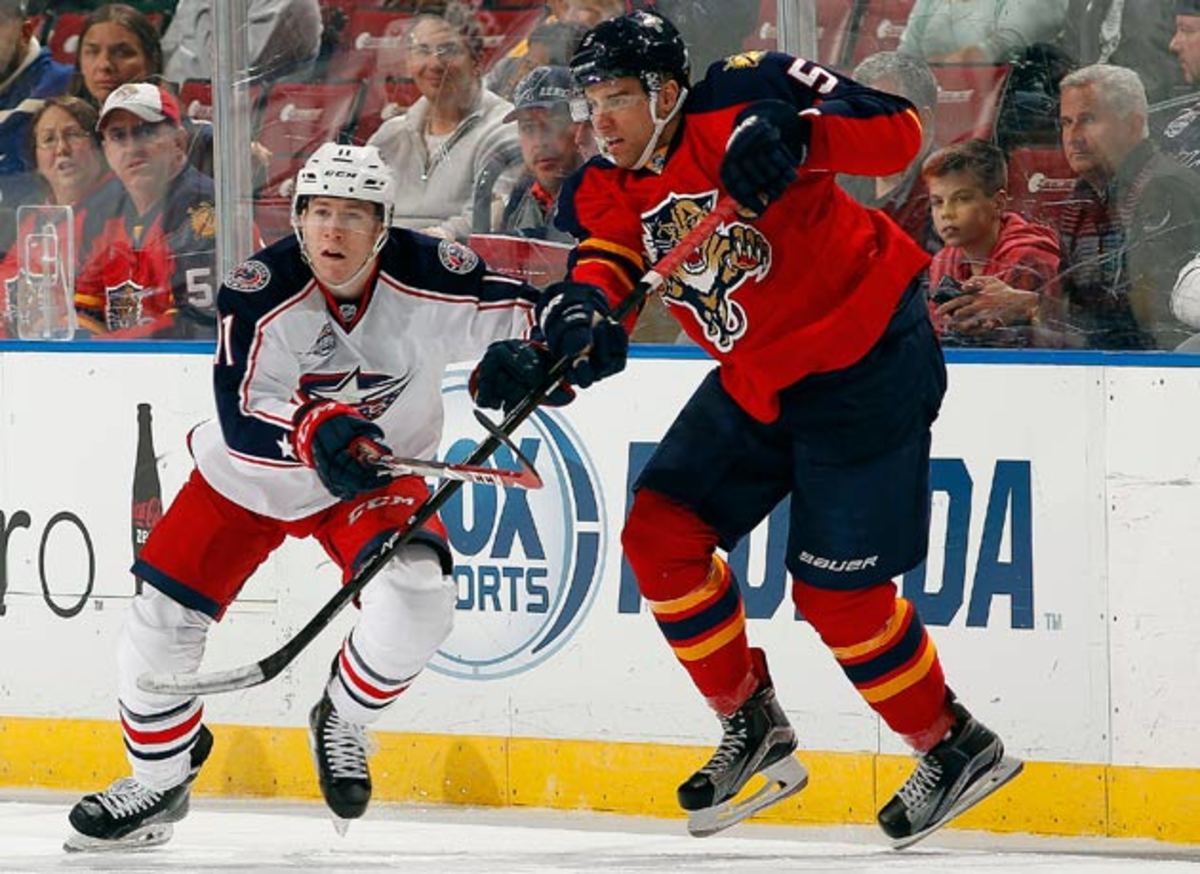
Over the past 15 years, Florida has largely been relegated to laughingstock status in the NHL. The Panthers have only made the postseason once since the 1999–2000 season. The announced attendance for their second home game this season was only 7,311, the lowest turnout in team history.
But in Ekblad, Florida may have finally found the face of the franchise—complete with light scruff and a swoop of dirty blonde hair.
Despite his boyish countenance, Ekblad is, at 6' 4" and 216-pounds, an imposing physical specimen. But beyond his measurements, what’s most striking about him is that he won’t accept anything but being the best. He wasn’t just the top pick in the NHL draft last summer, he was the first player selected in the 2011 OHL Priority Selection draft. Being No. 1 means something to him.
“I’m a little bit stubborn, to the point where I’m persistent enough where I want to be the best in everything,” Ekblad says. “I’m not going to say I’ve always been the best, but I’ve always worked the hardest to be given the opportunities to be the best. That’s what I want. I just want to push myself to be better and better.”
NHL's speedy possession game forging a revolution on the blue line
While the Panthers made their charge toward the playoffs, Ekblad built his strong case for winning the Calder Memorial Trophy, which honors the league’s best rookie. Predators winger Filip Forsberg was the early frontrunner, but it was Ekblad who earned a nomination along with two forwards, the Flames’ Johnny Gaudreau and the Senators’ Mark Stone. Ekblad came out on top in the voting, only the sixth defenseman since 1986 to win the award.
Making the leap to the NHL from junior hockey isn’t easy for any player. But for a young defenseman, the transition is arguably the toughest. Only six defensemen in NHL history have started a season at age 18 and finished with more than 25 points. Ekblad is one of them. His 39 points were only two shy of the NHL record for an 18-year-old defenseman set by his mentor and agent, Hall of Famer Bobby Orr, in 1966-67.
• SI Vault: Bobby Orr sets new standards of excellence (12/21/70)
For a young defenseman, Ekblad has a remarkable blend of poise, anticipation and reaction ability. But what sets him apart is that he also plays a full 200-foot game. His significant offensive contributions have led some in the league to make comparisons between Ekblad and his boyhood idol, Nicklas Lidstrom.
“They’re hard to find, players like that, and that’s why [Ekblad] was the first pick overall,” Florida general manager Dale Tallon says. “Usually it’s offensive and they’re not good defensively, or they’re good defensively and they don’t have any offense. But when you get the whole package, it really helps your franchise.”
That Ekblad has established himself as a force in the league so quickly has shocked even his biggest supporters. His parents, David and Lisa, both say they were just hoping for him to stick in the NHL at the beginning of the season.
Those who know Ekblad rave about his maturity. “He represents the game like we want players to represent the game,” Orr, considered the greatest defenseman of all time, says of Ekblad.
“It’s mostly been his maturity and his poise in the game,” says Panthers broadcaster and Hall of Fame defenseman Denis Potvin. “He’s not the fastest skater, the hardest shot, the biggest guy, all that stuff. There’s not one thing you can point at.… But those are the guys that tend to be great players—much more cerebral than most.”
• SI Vault: Undaunted, unhaunted Potvin rids himself of Orr's ghost (4/16/79)
When Florida coach Gerard Gallant first encountered Ekblad at rookie camp, he couldn’t believe that the kid was only 18. “He’s more like a 23- or 24-year-old,” Gallant says. “And that’s the way he carries himself.”
[pagebreak]

Ekblad spent his childhood in Southwestern Ontario on the border between the towns of Tecumseh and Belle River. He grew up cheering for the Red Wings, who played just across the Detroit River, though he hated watching hockey.
“I hated it because every time I was like, ‘Oh my God, I can do this, I can be doing this, I can do this right now. Why don’t I go do it?’ ” Ekblad says. Instead of watching, he’d run outside to the closest pond—or bound down the stairs to his basement—to shoot the puck.
For as long as he can remember, Ekblad has been a defenseman. He claims he played one game in goal as a young boy and literally fell asleep in net.
He started turning heads early on, but his stock began to skyrocket when he was an adolescent. When Ekblad was 14, he was playing Triple-A hockey with the Sun County Panthers— no affiliation with the NHL Panthers—when his teammates started calling him First Ovie, short for first overall. The nickname proved to be a harbinger of things to come.
Victor Hedman quietly grows into cornerstone of Lightning's defense
Todd Lalonde, Ekblad’s coach in his final two years at Sun County, recalls that Ekblad disliked the nickname and did whatever he could to deflect it. “He could have been that cocky arrogant punk—he’d [have been] justified,” Lalonde says. “But he was the exact opposite.”
At Sun County, it became clear to Lalonde that Ekblad was destined for stardom. When Lalonde drilled his defensemen on picking up the puck under pressure in their own zone, Ekblad quietly asked Lalonde to give him the least amount of time possible to gain possession of the puck.
“I can remember him saying to put the pucks deeper in the corner and make it harder. What 14-year-old says that?” Lalonde says. “Most guys are cheating at the drill, and he wants to make it harder. I remember that unequivocally as the moment when I knew he was going to be an elite pro.”
In 2011, Ekblad became just the second player (Islanders captain John Tavares was the first) to gain OHL exceptional player status, which allowed him to enter the league at age 15. Before Ekblad could officially apply for exceptional status, however, he had to convince his mother that it was the right move.
While Ekblad’s father and older brother were enthusiastic about the opportunity to send Aaron to the OHL, Lisa was hesitant. She felt that Aaron was too young to move away from home, worrying about him going to a new school, how he would feel being separated from his friends back home, his safety, homesickness and the potential negative influence of older guys in the locker room. There was also the physical danger of her son playing against opponents who were five years older.
Aaron, too, had reservations at first. One day before he moved to the OHL, during practice with Sun County, he pulled aside Lalonde and asked his coach whether he thought he was emotionally ready to play in the bigger league. “What 14-year-old kid asks a coach whether he is emotionally ready to play? I kind of giggled,” Lalonde says.
Lisa remembers Aaron addressing her worries one by one, patiently doing his best to alleviate her concerns. He drew up a list of the pros and cons of a move to the OHL. Lisa ultimately came around—and the rest is history: Ekblad emerged as a star in the OHL with the Barrie Colts, leading to his selection with the top pick in the NHL draft.
“I kind of feel that about kids in society today—they experience everything so young, and then what? It almost seems like it’s too much too soon,” Lisa says. “But in his case, it worked out.”

Both of Ekblad’s parents (above) say they aren’t entirely sure how their son got so mature. (“If I had a recipe, I would share it with you,” David says.) Aaron, though, credits his parents as his biggest influences, and his brother Darien—18 months his elder—agrees. “They were full of life lessons,” Darien says.
Darien, who played goaltender in the OHL before he started studying sport management at Niagara College, considers Aaron his best friend. They grew up playing hockey together, both on organized teams and in their basement. (During one basement session, Aaron broke Darien’s pinky toe with a shot.) Darien believes Aaron’s maturity off the ice made him a better hockey player.
“He was always kind of a softie when he was younger,” Darien says. “As he became older and more mature, he became more emotionally stable. That translated to his on-ice game too. He would bounce back from mistakes much quicker on the ice.”
Ranking NHL's 10 most promising defensemen under the age of 23
Ekblad, a teenager living across the country from his family, has learned to handle life as an NHL player. While adjusting to the travel demands has been difficult—particularly while playing against the best players in the world night after night—Ekblad hasn’t let the pressure overwhelm him. He is quick to credit his coaches and teammates for his development, particularly the tutelage of Mitchell.
Ekblad has also already learned to be thoughtful yet diplomatic with the media, even making sure to be deliberate about his Super Bowl pick. Prior to the 2014 season, Ekblad picked the Jaguars to win it all, because his father works for a company owned by Jacksonville owner Shahid Khan. The Jaguars finished 3-13.
Ekblad, who played in the All-Star Game on Jan. 25, isn’t a superstar yet. He’s the first to point out that a lot of work stands between him and his goals. Orr is quick to point out the same thing.
“It’s a grind for an 18-year-old, just turning 19,” Orr says. “It’s unbelievable what the kid is doing. He’s playing and he’s averaging 22 minutes a game. Amazing.”
Darien’s hockey career ended in the minors, but he doesn’t display any jealousy toward his brother. Instead, he discusses Aaron’s abilities and work ethic with a sense of awe.
“Growing up, for me I don’t know if I was ever committed to anything the way he was to hockey. It was almost like it was effortless even though he was putting in all the work,” Darien says. “Me coming short a little bit on talent in hockey, seeing his work ethic … I can kind of translate that to my academic life, in terms of career advancement and what not. He inspires me in that sense.”
During Florida’s surprising pursuit of the playoffs, Ekblad’s individual play remained steady, even as the spotlight grew brighter. Though turning around a franchise with major attendance problems and a history of losing is no easy task, Ekblad thrives under pressure.
“I appreciate a challenge and I play accordingly to that challenge,” he says. “The bigger the challenge the more I want to rise up to it.”
GALLERY: Top 25 Defensemen of All Time
Top 25 NHL Defensemen of All Time
25. Shea Weber

Weber is a complete defenseman. At 6’-4”, 235 pounds, he packs a mean streak and a cannonball shot. Though he’s still only 29, he already has six seasons of at least 16 goals on his resume and an Olympic gold medal he won while playing for Canada at the 2010 Games. He should win his first Norris Trophy before long, but his legacy will ride on whether he can win the Stanley Cup.
24. Borje Salming

The longtime Maple Leaf came over to the NHL during the Broad Street Bully days of the mid-70s when the league’s ruffians ate Swedish players for lunch. Salming took some brutal hackings and beatings, but he also won respect for playing through them and becoming a fine support player for the likes of Darryl Sittler and Lanny McDonald in Toronto. Salming earned five Second-Team All-Star selections and was a First-Team pick in 1977. He finished his career with 787 points and +175 rating in 1,148 games.
23. Rob Blake

The classic two-way defenseman was a stiff checker and steady puck mover who scored double figures in goals 13 times during a career that spanned 1,270 games and produced a Stanley Cup in Colorado and gold medals at the World Championships and Olympic Games while representing Canada. Though he never posted a 70-point season, Blake still amassed 777 points, a testament to his consistent production throughout his career. He also won the Norris Trophy in 1998 as an L.A. King.
22. Scott Niedermayer

The fleet Niedermayer was a remarkably effective offensive blueliner (35 or more points in a season nine times) during an age of clutch-and-grab on a defense-minded team. Despite the Devils’ restrictive system, he was able to shine, winning the Norris Trophy in 2004 and three Stanley Cups (1995, 2000, ’03) before adding another championship with his brother, Rob, with Anaheim while earning the Conn Smythe Trophy in 2007. A winner at every level of hockey at which he played, Niedermayer's mantel also holds gold medals from the Olympics (2002, '10), World Championship ('04), World Cup ('04), and World Junior Championship ('91).
21. Zdeno Chara
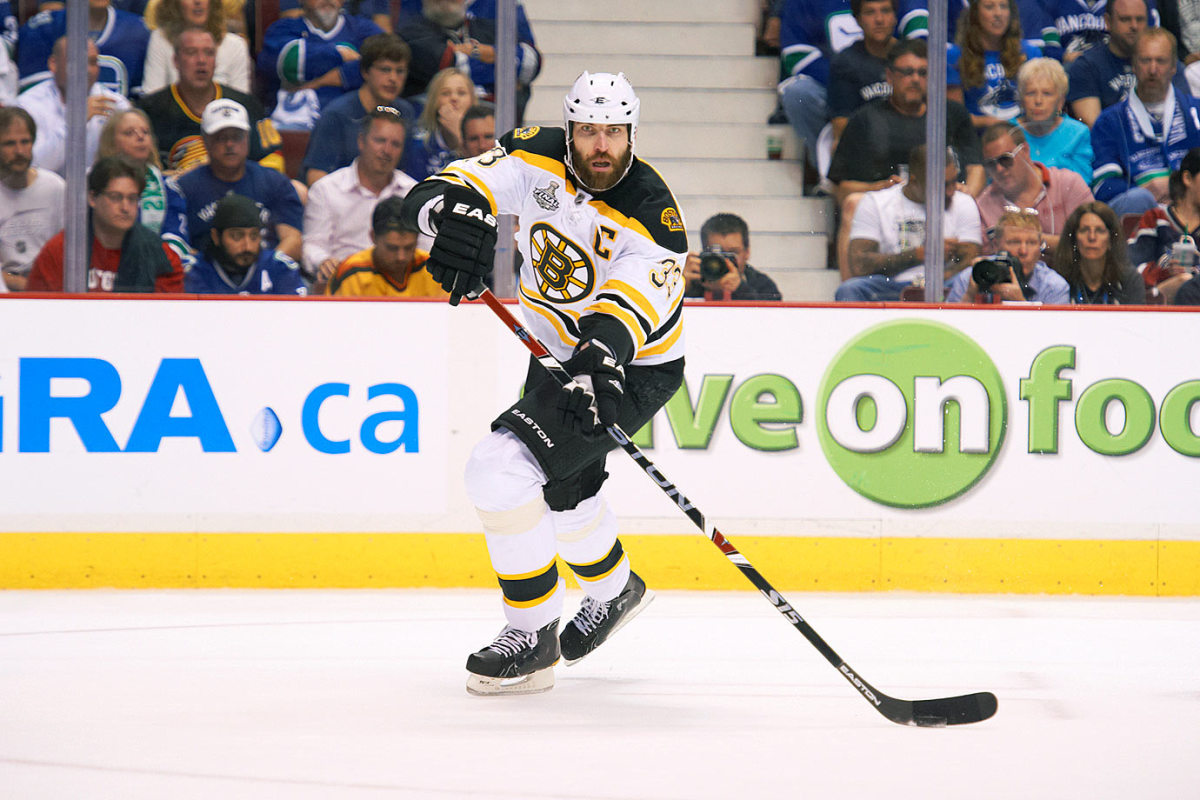
At 6’9”, Big Z is the tallest player ever to play in NHL and yet has remarkable dexterity and puck control for someone who towers over the league. Even at 38, the 17-year NHL veteran is still a scary foe to play against. Though he will always be remembered for a scary turnbuckle check against Montreal's Max Pacioretty, Chara is actually fairly controlled for a physical force he has been throughout his career, even with more than 1,600 penalty minutes in over 1,100 games played. He helped end Boston’s Stanley Cup draught with his brilliant play in the 2011 postseason.
20. Mark Howe

Gordie’s son didn’t have his dad’s mean streak but he earned enshrinement in the Hall of Fame as a defensive stalwart. In the 1980s, Howe played an astounding 30 straight games without being on the ice for an even-strength goal-against. The three-time Norris Trophy finalist was also a fine candidate for the Lady Byng, an unusual distinction for a defenseman, or the Masterton Trophy, having survived a gruesome injury in which the plate that used to keep the goal net firmly on the ice got stuck five inches into his hip.
19. Rod Langway

Langway made the Hall of Fame purely on his defensive skills. The two-time Norris winner was never especially fast, but he always seemed to cover a lot of ice because of his tenacious play along the boards and relentless pursuit of pucks and opposing forwards. He played the game with an attitude and was effective at keeping his crease clear. Langway won the Cup with Montreal in 1979 and later became a force with Washington for 11 seasons.
18. Larry Murphy

The Rodney Dangerfield of backliners was rarely fully appreciated for how durable (1,615 games), consistent (1,216 points) and successful (215 playoff games) he was. Murphy became an offensive star in Washington and won a pair of Cups with both Pittsburgh and Detroit. As a Red Wing, he was a fine complement to Nick Lidstrom as a team player.
17. Brad Park

The greatest defenseman of his generation who wasn’t named Orr, the physical, scrappy Park was an NHL First Team All-Star five times, a Second Teamer twice, and runner-up to Orr for the Norris on six occasions. Though he played on some outstanding teams with the Rangers and Bruins, Park never won the Stanley Cup. He did appear in 161 career playoff games and his teams never missed the postseason during his 18-year NHL career. He also topped the 20-goal mark three times and scored at least 10 goals 12 times.
16. Al MacInnis

Skilled at joining rushes and keeping pucks out of traffic areas in front of his net, MacInnis may have had the most devastating shot in hockey history. He was also able to keep his blasts low and control them so his teammates could tip them past goalies. His shot grew into legend after a game in 1984 when he fired a puck that split goalie Mike Liut’s mask into two pieces before bouncing into the net. A Cup winner in 1989 with Calgary, he finished his career with 1,274 career points.
15. Marcel Pronovost

Pronovost played in 11 All-Star Games and won five Cups, including four with Detroit and one with Toronto. A former forward, he played both positions early in his NHL career. During Toronto’s Cup run in 1967, the steady Pronovost was on the ice for only one even-strength goal-against during the entire postseason.
14. Paul Coffey
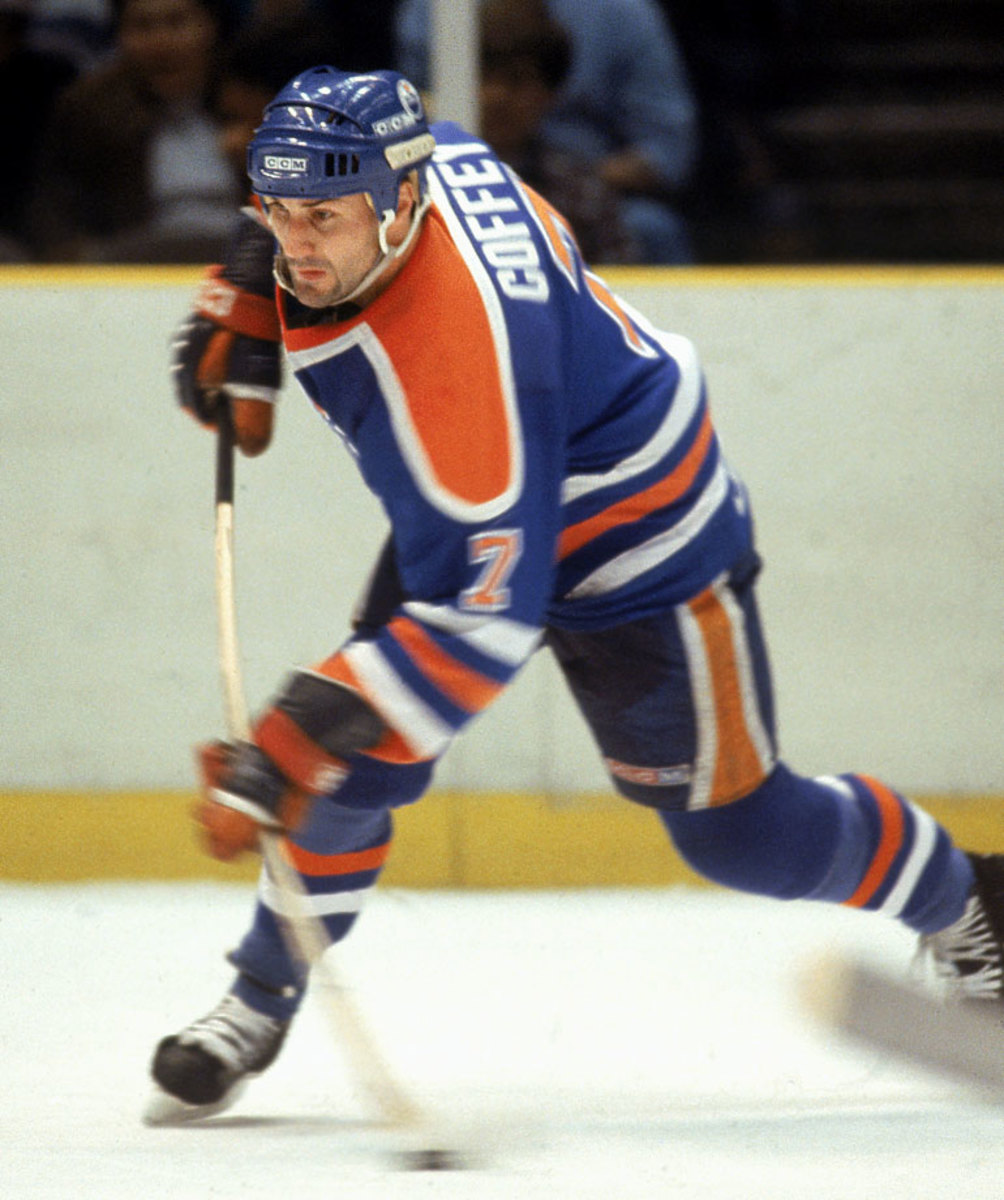
No defenseman since Bobby Orr has been as gifted. On the run-and-gun Oilers, the smooth-skating Coffey was deadly on the power play or the rush as a fourth man, a stealth trailer who feasted on chances produced by the likes of Wayne Gretzky, Mark Messier, Jari Kurri and Glenn Anderson. After winning three Cups with Edmonton, where he scored 48 goals in 1985-86, he added another with the Penguins in 1991, making him one of the fortunate few to ride shotgun with both Gretzky and Mario Lemieux in their heydays.
13. Scott Stevens
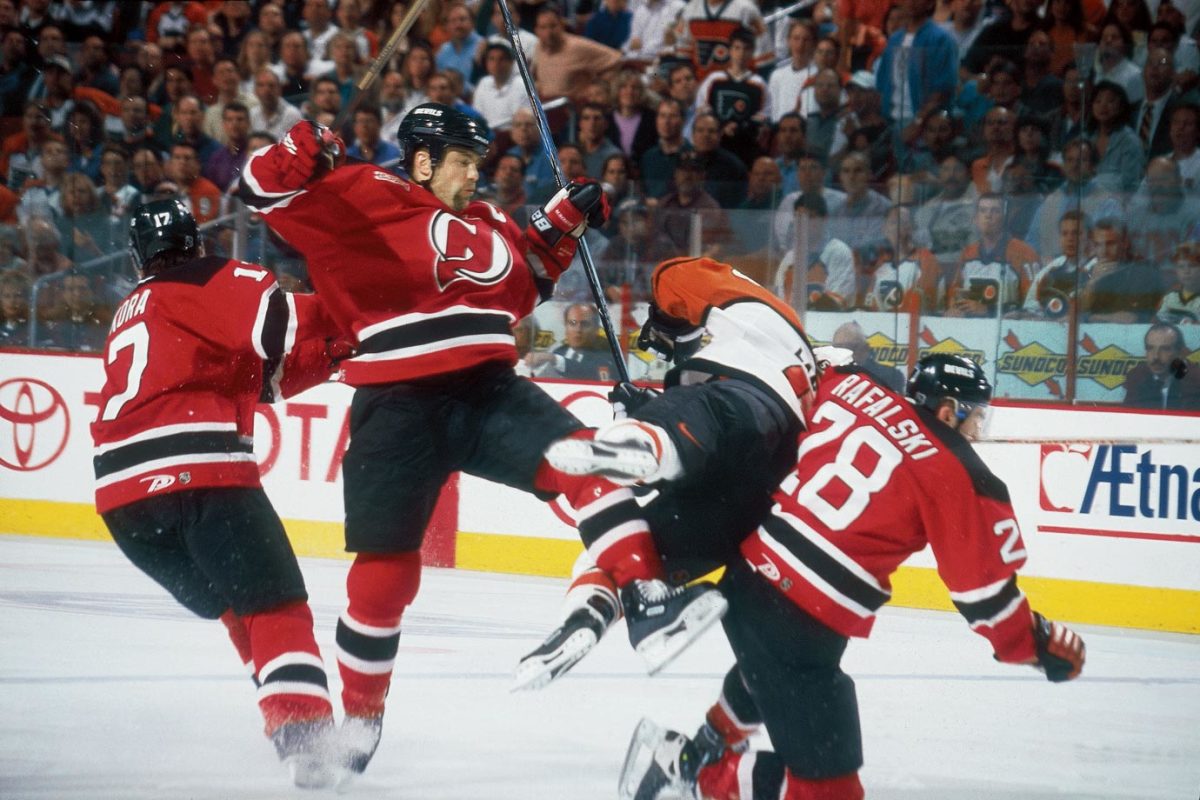
Arguably the most devastating checker of all time, Stevens knocked players senseless with hits that would get him suspended today. His most notorious was the one on the much larger Eric Lindros of the Flyers in the 2000 playoffs. A plus player in each of his 22 seasons, Stevens was more than adequate offensively (908 points) and he captained the Devils to the Cup in 1995, 2000 and ‘03.
12. Tim Horton

Now known for the donut chain that bears his name, Horton was one of the game’s steadiest, strongest defensemen. He held the NHL’s ironman mark for blueliners with 486 consecutive games played until Karlis Skrastins broke it in 2007, despite suffering a broken leg and jaw after being checked by Ranger Bill Gadsby in 1955. Horton played in 1,446 games, capturing four Stanley Cups with Toronto before playing with the Rangers, Penguins and Sabres.
11. Chris Pronger
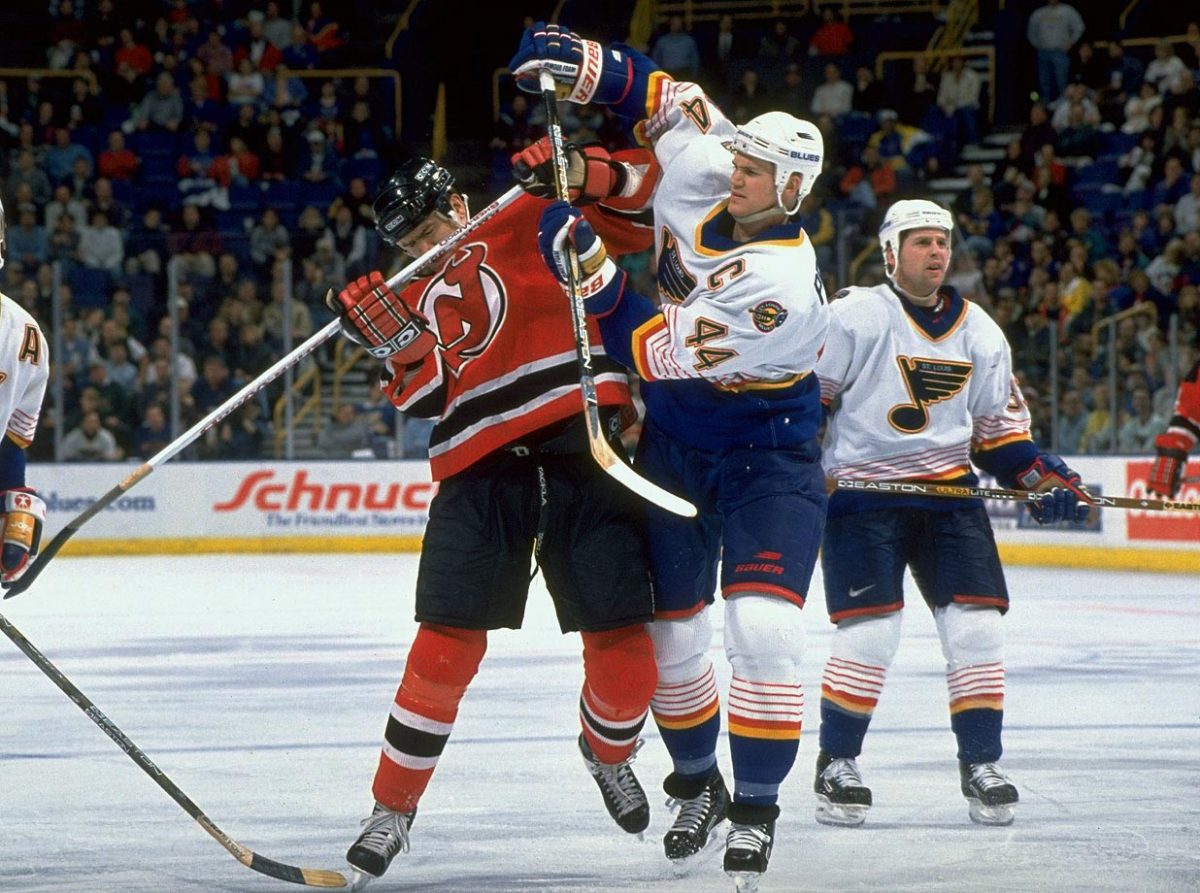
One of the meanest, most feared defensemen of his time, Pronger earned eight suspensions for excessive play, but he also had superb vision and anticipation that made him a deft outlet passer and defender who could afford to guess and take chances while playing aggressively. He reached the Cup finals with three different teams, winning the championship with Anaheim in 2007, and was inducted in the Hall of Fame in 2015.
10. Brian Leetch
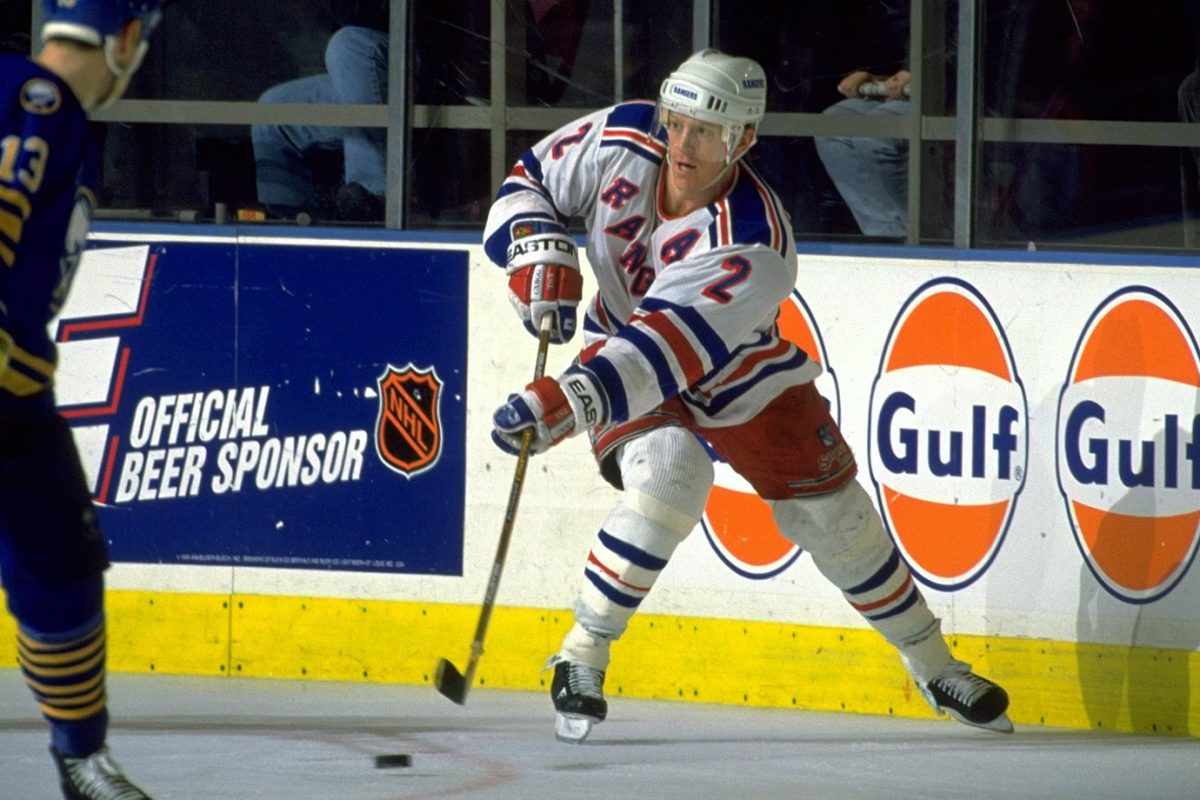
Perhaps the finest U.S.-born defenseman of all time, Leetch was a grab bag of skills. Though he lacked Paul Coffey’s speed and Al MacInnis’ shot, he had a knack for keeping pucks in at the point, making plays in traffic, riding bigger players off the puck in his own zone, and creating scoring chances out of broken plays. Leetch always saved his best play for pressure games, winning the Conn Smythe Trophy as playoff MVP in 1994 when the Rangers ended their 54-year Cup drought.
9. Pierre Pilote
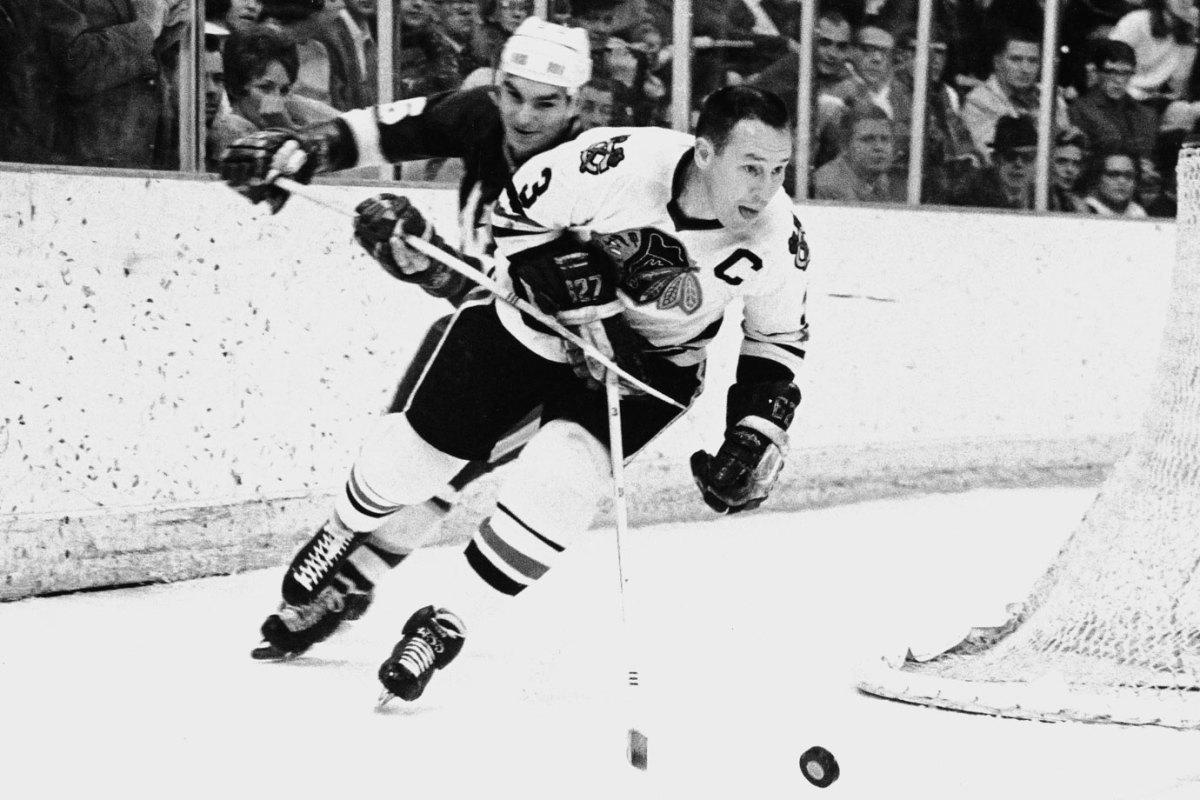
Pilote joined the Chicago in 1955, won the Stanley Cup in 1961 and became the Blackhawks’ captain the next season. Teamed with Moose Vasko for most of his career as one of the game’s top defensive tandems, he won three Norris Trophies and was runner-up three times. He had the offensive skills to be a fixture on the power play, scoring 14 goals in 1964-65 when Chicago again reached the Cup finals, and a nasty side with his stick, twice amassing 160 penalty minutes in a season.
8. Chris Chelios
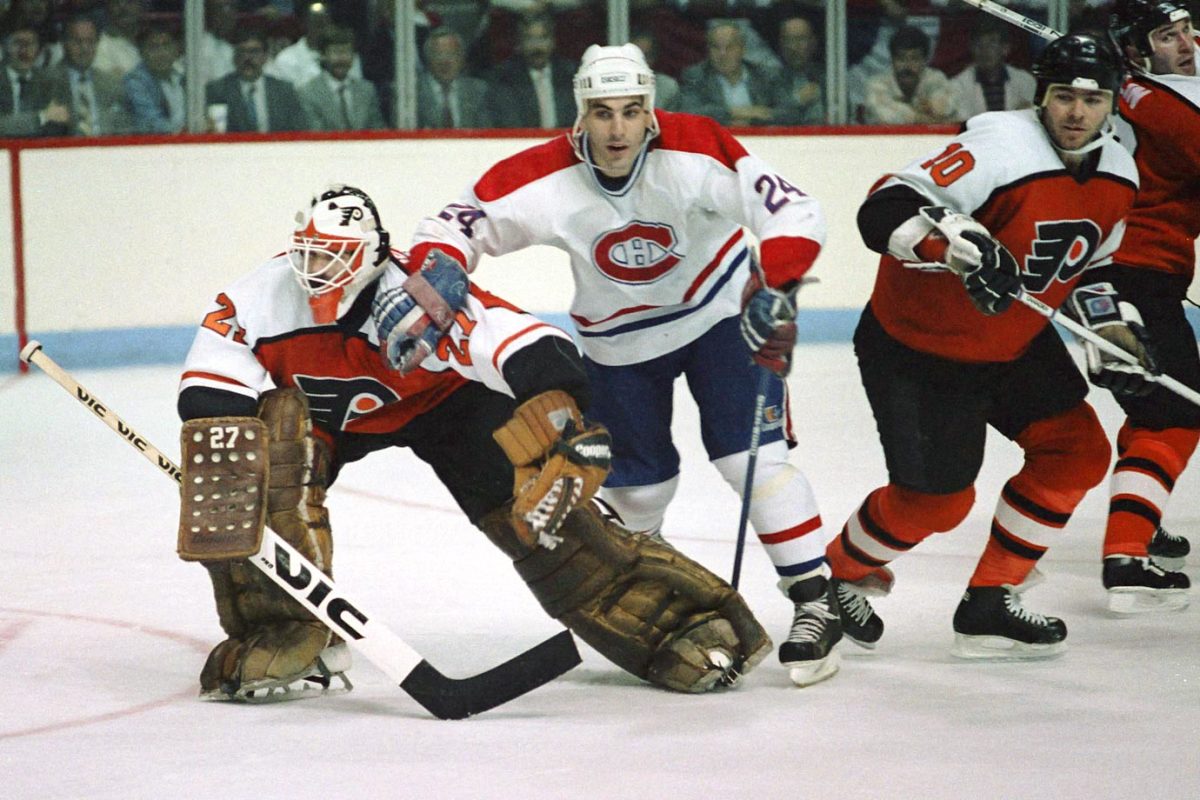
No one was more ill tempered or inspired more animosity in opponents. His 2,891 penalty minutes, second among NHL blueliners, were well earned. Flyers’ goalie Ron Hextall once compromised his team’s comeback in the closing minutes of a playoff game by chasing Chelios and pounding away. A three-time Norris Trophy winner, Cheli played to age 48 and his 1,651 games rank fifth all-time and first among defenseman.
7. Red Kelly

Kelly won eight Stanley Cups with Detroit and Toronto, more than any player who never played for Montreal, and the Norris Trophy in 1954, the year it was first awarded. When foot and leg injuries caught up to him, he actually moved up to play forward so he did not have to skate backwards as often, and he spent the last seven seasons of his 20-year career up front. When he retired, his 1,316 games played stood second only to Gordie Howe and ranked first among defensemen.
6. Larry Robinson
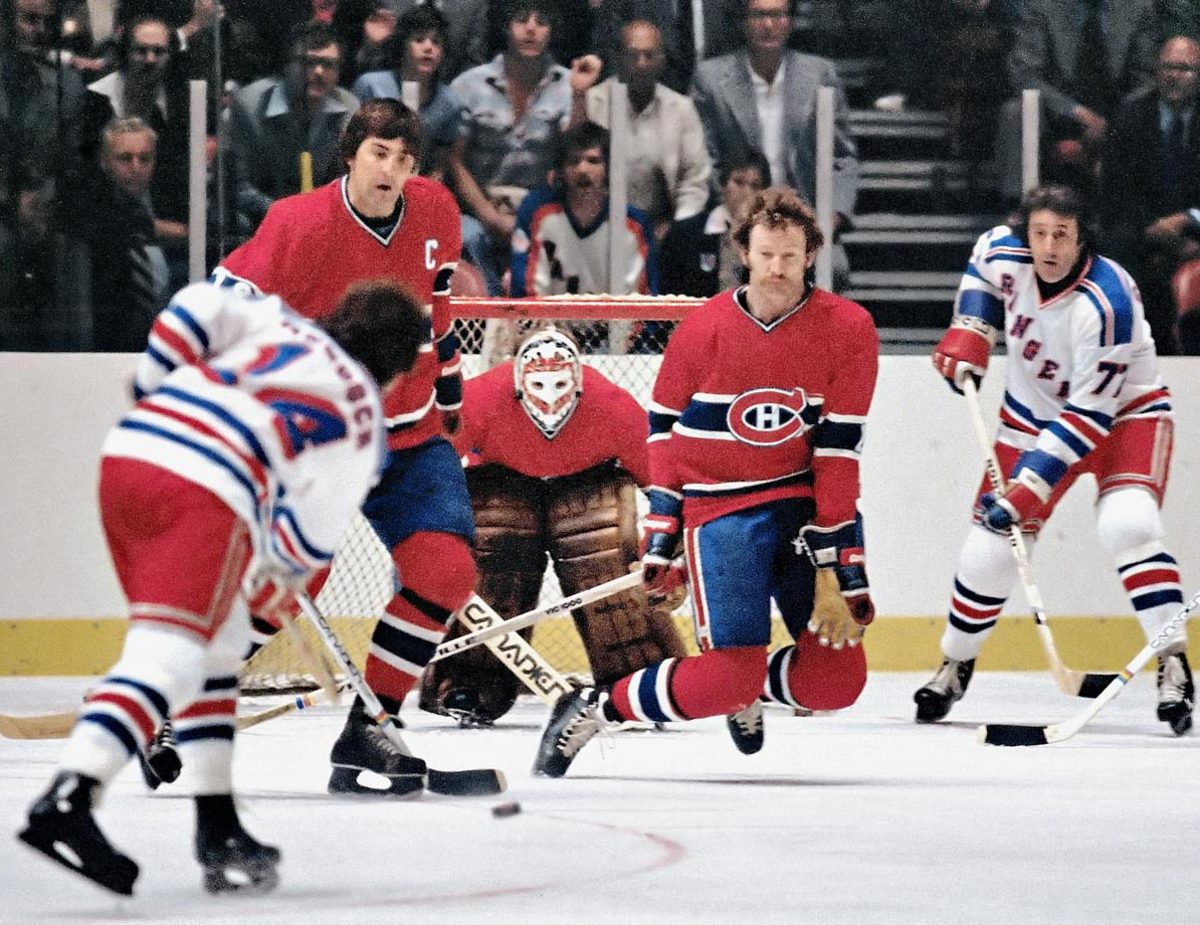
The 6’-4” Robinson was the ace of a Montreal defense corps that anchored four straight Stanley Cup teams (1976-79). He combined the offensive skills of backline partner Guy Lapointe and the defensive stinginess of Serge Savard, and his long reach made him tough to elude. He finished his career with the highest plus-minus rating (+730) in NHL history and later won his seventh Cup as coach of the Devils in 2000.
5. Denis Potvin

The 1974 Calder Trophy winner enjoyed his heyday as captain of the Islanders during their four consecutive Stanley Cups (1980-83). A three-time Norris winner, Potvin was an offensive force (310 goals; 1,052 points) and rugged bodychecker whose name still rings about the rafters of Madison Square Garden as fans of his crosstown rival Rangers invoke his memory with a vitriol reserved for few retired players in any building.
4. Nicklas Lidstrom

Lidstrom, a 2015 Hall of Famer, was called the perfect hockey player, a testament to his offensive wizardry, defensive subtlety, overall acumen and gentlemanly play. This four-time Stanley Cup winner with 1,142 career points and seven Norris Trophies was perhaps the least likely superstar to make a careless error or costly play. His Red Wings reached the playoffs each season of his 20-year career.
3. Doug Harvey

Described by the legendary Jean Believeau as the game’s greatest defenseman, Harvey was known for his superb skating and passing skills. He won the Norris Trophy seven times and was named to the NHL All-Star team 11 times. He was a key player for the Canadiens on six Stanley Cup championship teams, including their record five in a row (1956-60), before moving on to the Rangers when Montreal traded him in 1961 as punishment for helping to organize the players’ association.
2. Ray Bourque

Few have played with the quiet leadership and integrity of Bourque, the all-time leader among defensemen in goals (410), assists (1,169) and points (1,579). After two trips to the Cup finals, 13 First-Team All-Star selections, and six Second-Team nods with Boston, he welcomed a trade to Colorado as a final chance to play for the title. Perhaps no player’s skate with the Stanley Cup met with as much joy as Bourque’s celebrating during his final game in 2001.
1. Bobby Orr
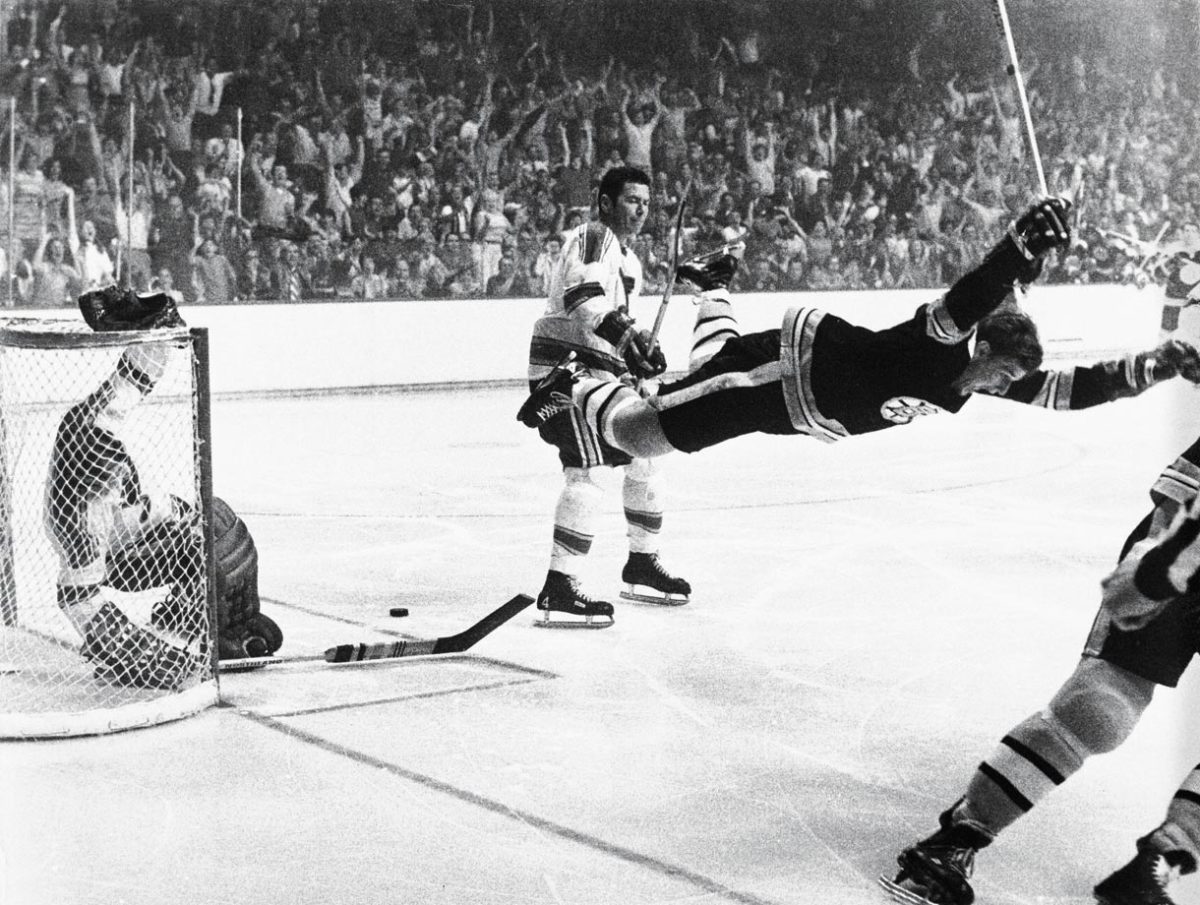
The legendary Bruin redefined what the position could do, joining rushes and sometimes creating them from his own end of the ice. Orr won eight straight Norris Trophies (1968- 75), three Harts and two scoring titles, an unheard of accomplishment for a defenseman. He led Boston, league also-rans before his arrival, to the Stanley Cup in 1970 and 1972, when he also won the Conn Smythe Trophy.
